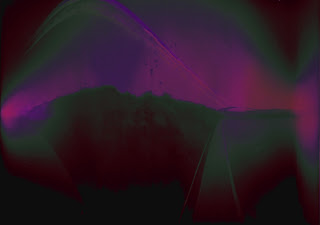Anyway, I tested out the equipment from the location of the seconds pinhole camera that looks out over the local motorway. I should say that at 3pm this motorway is very busy and the result made it look like a ghost road! I am wondering whether I should explore this branch of photography further and going into town when it is busy and get some "ghost" town shots.
A fantastic, and great way to test out the camera and the settings that I had carefully selected. Onto the next test.....
Second test of the day was to capture the changing of the sky as the sun was setting. I adjusted the settings slightly to factor in the changing of the light and conditions, who knew that I would be using Maths and Science to take photographs! So......here is the result, and again I am really pleased as it shows the motion of how the clouds move across the sky and the colours developing over time.
Next test it to try and capture water.....






